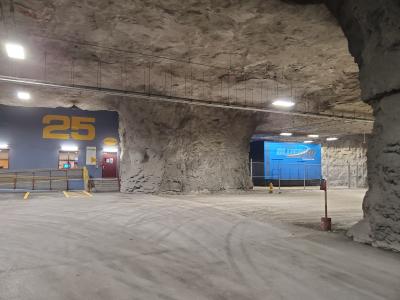-
Underground data centers do exist today and are primarily housed in mines
-
These facilities boast constant temperature and humidity as well as increased security and resilience, executives from LightEdge and Bluebird Network told Silverlinings
-
The downside is there aren't enough suitable mines available for the design to go mainstream
It is a truth universally acknowledged that data centers are ugly. Really, truly hideous structures. This is the case despite efforts by local officials to regulate data center aesthetics. As campuses proliferate and grow in size to meet rising demand for compute, these architectural monstrosities are taking up more and more land. But does it really have to be this way? Joe Reele, VP of Solution Architects at Schneider Electric, doesn’t think so.
“We need to significantly change the way we build data centers,” he told Silverlinings. Schneider Electric is a global specialist in power, cooling and software for data centers.
Reele’s argument on this front is primarily an environmental one. He noted, for instance, that greenspace is finite and rather than building data centers on top of what is left, perhaps we should start looking at options to go below the surface.
This, he said, would not only allow the land above to remain arable and eliminate aesthetic concerns but also provide more construction space and security for data centers. Plus, he said, heat generated by the data centers below ground could easily be captured and reused in above ground facilities.
Thus, our epic adventure into the deep began.
What’s out there
While this might sound far-fetched at first, underground data centers already exist. By and large, today’s underground data centers are built in unused parts of mines, some of which remain active.

For instance, Iron Mountain has one in Pennsylvania outside Pittsburgh in the U.S. and Bluebird Network has one in Missouri. The former is 220 feet underground and uses 35-acre aquifer as a natural geothermal cooling source. The latter is housed 85-feet below the surface with a limestone surround that – along with redundant cooling and chilled water systems help keep the data center at an ambient temperature of between 64- and 68-degrees Fahrenheit.
LightEdge built its first underground data center in 2014 and acquired a second 125-feet below ground in Kansas when it bought Cavern Technologies in 2021. Elsewhere, the sprawling six-level Lefdal data center sits in an abandoned mine in Norway.
Lest you think otherwise, these are all full-sized data centers. The one in Kansas, for instance, is 102,000 square feet, while Iron Mountain’s is a sprawling 330,000 square feet.
Just fine in the mine
LightEdge COO Jeff Springborn and Greg Cantrell, facilities manager at Bluebird Underground, told Silverlinings underground facilities offer a range of benefits, primarily around security and resiliency. On the security front, entrance to the mines is restricted, as is entrance to the data center’s section of the mine, they said. And the fact that the data center is underground also means it’s immune from most natural disasters – like tornadoes, hurricanes and fires – as well as potential physical attacks.
Cantrell said the two most common questions he gets in terms of natural disasters are related to floods and earthquakes, but he noted the mine’s engineers have already planned for both.
On the attack front, Cantrell pointed out that critical data center infrastructure for an underground facility, like its cooling and power equipment, isn’t visible on Google Maps the way the same would be for an above ground data center. That offers an extra layer of security.
The added security of the underground environment tends to appeal to customers in the government, healthcare and financial markets, both said.
Springborn and Cantrell also said building in mines allows for faster data center construction and lower costs, since the outside shell of the data center doesn’t need to withstand as much as an above-ground shell would.
(No data centers in Moria, just cave trolls and a Balrog.)
“We can build a shell pretty cheaply in about 90 days versus above ground you’re probably spending $600 a square foot to build something that’s pretty hardened for F4, F5 tornadoes,” Springborn explained.
Cantrell also noted the mine’s temperature and humidity remains nearly constant year-round, meaning Bluebird doesn’t have to deal with spikes in cooling or electricity costs. And, because its cooling and power equipment is not exposed to the elements above ground, it lasts longer, he added.
So, what’s the catch?
Asked why underground facilities aren’t more popular if they carry all these benefits, Springborn and Cantrell said there’s simply a limited number of suitable mines available that are in the right proximity to power and connectivity facilities.
They said in theory you could dig your own hole to bury a data center in (as rumor has it Walmart has done somewhere in the middle of the country), but then you’d need to build a stronger shell to withstand the weight of all that soil and would thus lose the cost benefit associated with building in a mine.
For those brave enough to venture below the surface in their footsteps, Cantrell and Springborn offered the following words of wisdom: Get an engineering firm who knows what they’re doing and has experience working in mines. Otherwise, you could end up walking quite a rocky road (pun absolutely intended).
*UPDATE 10/24/2023 3:41 pm ET: This story has been updated to reflect the fact that LightEdge has two, not one, underground facilities.
Want to discuss AI workloads, automation and data center physical infrastructure challenges with us? Meet us in Sonoma, Calif., from Dec. 6-7 for our Cloud Executive Summit. You won't be sorry.